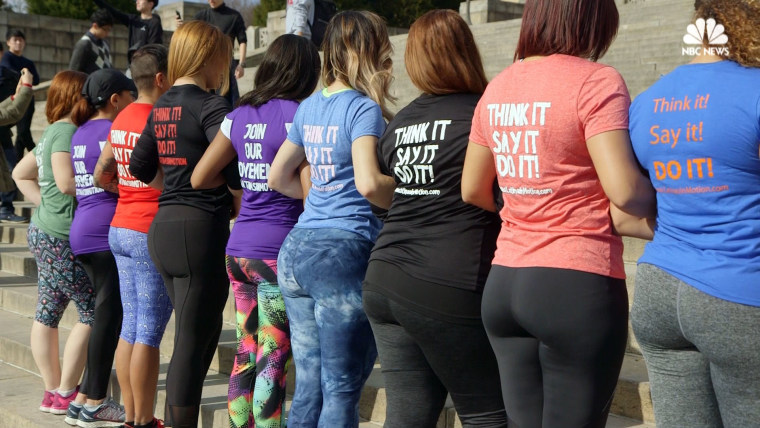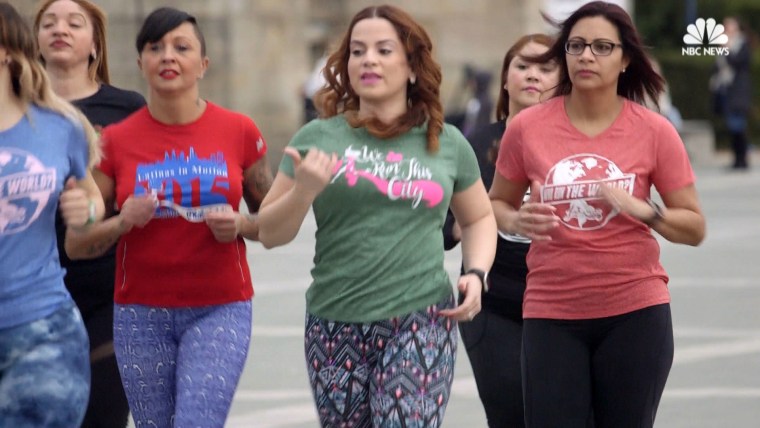On a June afternoon in late 2012, Elaine Gonzalez Johnson, frustrated by running alone, sent a text to every woman in her phone and launched a nationwide movement.
‘I’m going to run two-and-a-half miles on Saturday at 7 AM,’ it read. ‘Will you join me?’
A month earlier, Johnson — now a 30-year-old full-time program manager in the Philadelphia school district — had stood at the starting line of her first-ever race, Philadelphia’s Broad Street Run, which touts itself as the largest 10-mile race in the country. Despite being in a crowd of over 35,000 fellow runners, she felt alone. “I didn’t see anybody who looked like me,” Johnson said. “There was such a lack of Latinas at this particular race.”
Johnson’s initial impression was not far off from the truth: despite their status as the country’s largest racial or ethnic minority, at 17.6% of the nation’s total population, Hispanics make up only a small portion of runners nationwide. In 2016, only 6 percent of overall runners surveyed identified as Hispanic, according to RunningUSA, a not-for-profit organization launched in 1999 which tracks developments in the sport through annual surveys and reports. And for women runners, the figures are even bleaker: barely 5 percent of female runners surveyed by the organization in 2014 identified as Hispanic.

Within weeks after the Broad Street Run, Johnson decided to take matters into her own hands. In June, a few days after she texted all the women she knew, six women showed up to meet her for an early morning two-and-a-half mile run at Abraham Lincoln High School in northeast Philadelphia. The group began to grow every week. And by August of that year, a chapter had sprung up in New Jersey. Latinas in Motion was born.
RELATED: Latina Conferences: #WeAllGrow 2017 Unites Latina Entrepreneurs
Almost five years later, the group boasts 4,000 members in 17 chapters across 14 states and in Puerto Rico, where Johnson’s family hails from. And Johnson has become the face of the movement, appearing on the cover of Women’s Running magazine last June.
“Until I ran Broad Street, I just didn’t realize that there was such an underrepresentation of women of color at these races,” she said. “I realized I wanted to create a platform for women, specifically Latinas, to find this sense of self and accomplishment.”
For Johnson, running was the first type of exercise that gave her the sense of sweaty accomplishment she would later seek to instill in others. She began exercising consistently in July 2011 in an effort to lose the 50 pounds she had gained while pregnant with her daughter, Eva, the year before.
“I just had this feeling of unhappiness, depression, stress,” she said. “I had never, ever been athletic, never worked out, never been fit.” She gravitated towards walking when she realized she “didn’t know what to do at the gym.” Soon after, walking became jogging, jogging became running, and she became hooked on post-run endorphins. She lost 50 pounds in nine months. “Every time I ran, I felt amazing afterwards,” she said. “I just felt like I found myself.”
Today, Latinas in Motion chapters typically meet at least once a week, adding swimming, spinning, and Zumba into the repertoire — along with potluck dinners and outings to paint classes — whenever they feel like switching it up. And in 2015, the group hosted their first-ever public race: the Peace, Love, and Run 5K in Philadelphia, which attracted 350 entrants. Last year, Johnson added a children’s quarter-mile race — which attracted 55 runners — in an effort to begin to reach out to the next generation of Latinos and reverse what she characterized as unhealthy cultural norms and habits.
While a recent study by the National Sporting Goods Association found that 79 percent of Hispanics surveyed said that ‘bonding with family’ was an extremely or very important reason for participating in sports and exercise, Johnson acknowledged that in her upbringing, family time was centered around food rather than fitness.

“You don’t know what you don’t know, and food is such a staple in everything [Latinos] do — from promotions to birthdays and weddings,” she said. “Family time is so sacred in our culture, but fitness isn’t talked about.” According to the Centers of Disease Control and Prevention, Hispanics are 23 percent more likely to be obese and 50 percent more likely to die from diabetes or liver disease than whites.
These statistics are also what motivated Johnson to create the Latinas in Motion Legacy Program, a six-week pilot program that will focus on fitness and goal-setting for teen girls in a Philadelphia public high school. The program will be rolled out this month, and Johnson hopes it will eventually be rolled out in every city where Latinas in Motion has a chapter. “How can we create a system where we’re reaching our younger generation? If I can reach back, if I can get to the younger generation, it will become our norm.”
Latinas are not the only minority group with dismal participation rates in running: each minority group surveyed by RunningUSA in 2016 had an individual participation rate below 10 percent, despite the rise of running groups like Latinas in Motion and other similar ones — such as Latinos Run, Black Men Run, and Black Girls Run — which specifically target minority groups. The 2016 survey also found that 63 percent of overall runners make $50,000 or more per year, and 79 percent have a bachelor’s degree or higher.
RELATED: Opinion: Birth Control Gives Women the Power to Decide
Rich Harshbarger, the CEO of RunningUSA, said the statistics reflect the reality that key actors in the running industry — such as race directors and sports marketers — have relied for too long on the boom that carried participation in the sport since it became popular nationally in the 70’s and 80’s. Instead, the industry could target new runners of different ethnic groups and socioeconomic strata who may be hindered from participating by high race entry fees or expensive gear.
“Event directors have to be more aware than ever before of how they’re marketing their race and offering experiences and pricing those offerings,” he said. “They haven’t had to be as worried because growth has been endemic for 25 years, and now they have to be.”
Harshbarger suggested race directors and sports marketers expand their marketing and promotional materials to be printed in languages beyond English and create races for minority groups to broaden participation in the sport. “It will take education and finding the right people to make that happen,” he said.
Latinas in Motion members echo Johnson’s mission to use their involvement in running to inculcate healthy habits in their own families; many — including Johnson — bring their children to races, weekend workouts, and weeknight runs. For Zulma Gonzalez-Lombardo, 50, the effect her athletic transformation had on her life was not lost on her family. “Six years ago, my family saw someone who was on the couch, not moving, only working and coming home, tired most of the time,” she said. “Now, they see this is part of my life.”
After running her first race in 2012, Gonzalez-Lombardo joined Latinas in Motion in 2014 and ran the New York City Marathon last year. “I never thought I would run a marathon, but it’s about breaking cycles.” Now, she co-runs the group’s South New Jersey chapter, which boasts 350 members.
Carmen Hernandez, 41, who also co-runs the South Jersey chapter, started running with Latinas in Motion in 2013 after a high school friend encouraged her to join the group. The sense of group camaraderie, along with the running, has kept her coming back four years on. "We always say we never leave a woman behind, and we don't," she said. "These women embrace you no matter your background.
When Johnson reached out to Nereida Santa-Barrientos, 34, in 2013, she was struggling with postpartum depression after the birth of her son and had sworn off running after logging many miles while serving in the military years earlier. “I had gained weight, I was a new mom and a new wife,” she said. “But Elaine said, ‘you have to try running.’”
Santa-Barrientos joined the group for a walk around New Jersey’s Cooper River Park. Within two months, her walk-jog routine had turned into a steady run, and she now runs the South Jersey chapter with Gonzalez-Lombardo and Hernandez. “This group helped me mentally and physically,” Santa-Barrientos said. “It’s empowering to see these women that are just like you and can do such amazing things. It makes you want to do better and to be more active.”
For now, Johnson is working to expand Latinas in Motion’s reach to both the young and the old in order to reach her ultimate goal of having “a chapter in every state.”
“I believe everybody is a runner,” she said. “Fitness is not a one-size-fits-all. Whether you’re doing a five-minute mile or a 15-minute mile, we’re both running a mile. As long as you’re moving, it counts.”
For more information on how to get involved with Latinas in Motion, visit: http://latinasinmotion.com/
